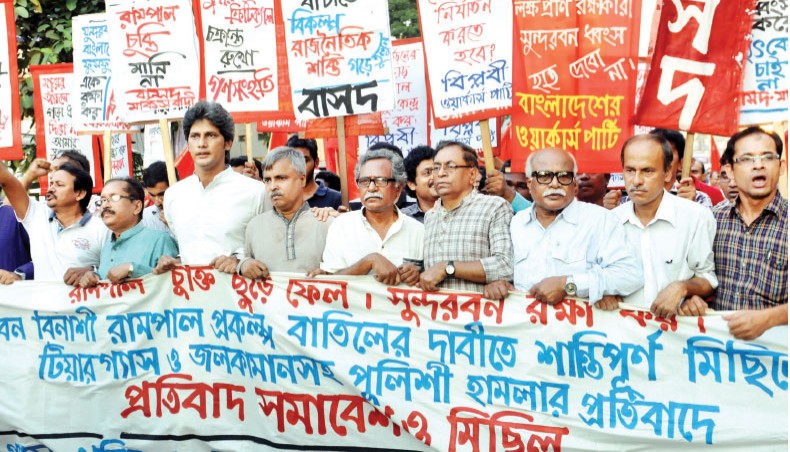National Committee brings out a procession, demanding cancellation of Rampal power plant and protesting against police action on anti-Rampal campaigners, in Dhaka on Thursday.
Ohio-based IEEFA suspects project is being promoted as a means to sell Indian coal to Bangladesh
The UN agency devoted to preserving world heritage has joined environmental groups urging Bangladesh to halt plans for a massive coal-fired power plant near ecologically sensitive mangrove forests on the coast.
UNESCO says it poses a ‘serious threat’ to a region that protects the nation from flooding and holds one of the world’s last populations of wild tigers.
Bangladesh countered on Thursday that the concerns were misplaced, and that it would continue with construction as the 1.3-gigawatt Rampal power station was crucial for expanding electricity capacity in a country where only six out of 10 people have access. It said the report released this week by UNESCO and the International Union for the Conservation of Nature ignored government assurances that the plant would be safe.
‘They have prepared the report from their own point of view. Our concerns have not been included,’ said Nasrul Hamid, the country’s junior power minister.
The $1.8 billion project — approved in 2012 under a joint venture between the Indian and Bangladeshi state power companies — calls for building what would be Bangladesh’s largest coal plant just 65 kilometres from the low-lying delta region called the Sunderbans, comprised of about 200 islands at the northern fringe of the Bay of Bengal.
The Sunderbans, formed over millennia as rivers deposited silt carried down from the Himalayas, is teeming with wildlife including a few hundred endangered tigers and endangered species of river dolphins.
It is also home to some 13 million impoverished Bangladeshis and Indians, who are mostly off the electricity grid and would not benefit directly from the project.
Most of the Sunderbans region is located in Bangladesh, with a third falling within India. For both countries, the vast network of islands and mangrove forests acts as a barrier against cyclone winds, storm surges and fast-rising seas that threaten to swamp inland areas — including the densely populated cities of Dhaka and Kolkata.
For years, environmental groups have lambasted the plans as a threat to an ecosystem so unique it is listed as a UNESCO World Heritage Site.
In a 35-page report , UNESCO and the IUCN agreed and called for the project to be scrapped immediately ‘and relocated to a more suitable location where it would not impact negatively on the Sunderbans.’
The report raised concerns about pollution, acid rain and potential damage from the dredging needed to make way for coal-carrying ships to reach the plant from the bay.
It also said that the threat to the region’s freshwater supply was of ‘utmost concern’ and ‘required urgent, immediate attention.’ With upstream dams and heavy demand for agriculture, the amount of freshwater that reaches the bay — and protects against saltwater incursion — has already fallen drastically, experts say.
Earlier this month, Bangladesh offered a response to UNESCO’s preliminary report, saying it would continue construction with the latest technologies and following international guidelines to ensure it did not harm the Sunderbans.
A report in June by a global energy research institute disputed that, saying the Rampal power plant is ‘fraught with unacceptable risk’ including a location that falls within a cyclone corridor, heavy local opposition and a risk of higher taxes and energy prices to cover some $3 billion in planned subsidies.
‘The project is being designed around outdated supercritical technology and is being heavily subsidized by the Indian and Bangladeshi governments,’ the Ohio-based Institute for Energy Economics and Financial Analysis said in the report , adding that it ‘suspects that the project is being promoted as a means to sell Indian coal to Bangladesh.’
The institute also questioned the effort to ramp up electricity by burning more coal, a significant source of carbon dioxide, at a time when the world is trying to curb the release of climate-warming emissions.
Bangladesh insists, however, that the plant is key to reaching its target of 24 GW of electricity capacity by 2021. That’s more than double the 10 GW capacity it logged in 2014, the vast majority of which is fuelled by burning coal. Demand often outstrips supply, resulting in shortages and blackouts.
Source: New Age

